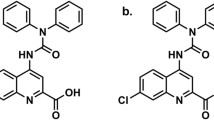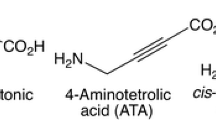Abstract
Ethylenediamine (EDA) and piperazine are known GABA-A receptor agonists and this activity appears to reside in their carbamate adducts. In CO2-free incubation medium EDA and piperazine weakly reverse the inhibitory action of 1 μM GABA on specific, [35S]t-butylbicyclophosphorothionate (35S-TBPS) binding to rat brain membranes in vitro. In 25 mM sodium bicarbonate buffer, EDA and piperazine much more potently inhibit35S-TBPS binding in a way reversible by the GABA-A receptor blocker R5135. Thus, native EDA and piperazine are weak GABA-A receptor blockers, while their presumed carbamate adducts, formed by reaction with bicarbonate, are more potent GABA-A receptor agonists. Virtually all structural modifications of EDA or piperazine result in GABA-A receptor blockers, even in the presence of bicarbonate, judging from their abilities to fully or partially reverse the inhibitory effect of GABA on35S-TBPS binding. Of 12 non-aromatic piperazine or EDA derivatives, the piperazine derivatives are the more potent GABA antagonists, although all are weak compared to the mono N-aryl derivatives. Nineteen mono N-aryl EDA derivatives are moderately potent GABA antagonists, including 10 with demonstrated or potential antidepressant activity. Most of the N-aryl piperazines are moderately to highly potent GABA antagonists one (pitrazepin) being 4 to 5 times more potent than bicuculline. There are several clinically effective antidepressants (e.g. Amoxapine, Mianserine) and antipsychotics (Clothiapine, Loxapine, Metiapine, Clozapine and Fluperlapine) among the more potent N-aryl piperazine GABA antagonists. We suggest that the antidepressant and antipsychotic effects, as well as the convulsions, anxiety, panic attacks and insomnia caused by the much studied 1-(m-chlorophenyl-piperazine) may be due to GABA-A receptor blockade. It might be worthwhile to clinically test additional N-aryl piperazines and N-aryl EDAs for antidepressant/antipsychotic activity.
Similar content being viewed by others
References
Squires, R. F., Casida, J. E., Richardson, M., and Saederup, E. 1983. [35S]t-Butylbicyclophosphorothionate binds with high affinity to brain-specific sites coupled to γ-aminobutyric acid-A and ion recognition sites. Mol. Pharmacol. 23:326–336.
Squires, R. F., and Saederup, E. 1987. GABAA receptor blockers reverse the inhibitory effect of GABA on brain-specific [35S]TBPS binding. Brain Res. 414:357–364.
Squires, R. F., and Saederup, E. 1988. Antidepressants and metabolites that block GABAA receptors coupled to [35S]t-butylbicyclophosphorothionate binding sites in rat brain. Brain Res. 441:15–22.
Squires, R. F., and Saederup, E. 1991. A review of evidence for GABergic predominance/glutamatergic deficit as a common etiological factor in both schizophrenia and affective psychoses: more support for a continuum hypothesis of “functional” psychosis. Neurochem. Res. 16:1099–1111.
Dalkara, T., Saederup, E., Squires, R. F., and Krnjevic, K. 1986. Iontophoretic studies on rat hippocampus with some novel GABA antagonists. Life Sci. 39:415–422.
Perkins, M. N., and Stone, T. W., 1981. An ionophoretic study of the structure activity relationships between analogues and derivative of ethylenediamine. Brit. J. Pharmacol. 74:887P.
Perkins, M. N., Bowery, N. G., Hill, D. R., and Stone, T. W. 1981. Neuronal responses to ethylenediamine: preferential blockade by bicuculline. Neurosci. Lett. 23:325–327.
Hill, D. R. 1983. The GABA-mimetic activity of ethylenediamine is dependent upon physiological concentrations of HCO −3 ions. Br. J. Pharmacol. 79:268P.
Stone, T. W., and Perkins, M. N. 1984. Ethylenediamine as a GABA-mimetic. TIPS: 5:241–243.
Rollo, I. M. 1965. Drugs used in the chemotherapy of helminthiasis. Pages 1058–1086 in: Goodman and Gilman (eds.) 3rd edition, Pharmacological Basis of Therapeutics. Macmillan, New York.
Martin, R. J. 1982. Electrophysiological effects of piperazine and diethyl-carbamazine on Ascaris suum somatic muscle. Br. J. Pharmacol. 77:255–265.
Shinozaki, H., and Konishi, S. 1970. Actions of several anthelmintics and insecticides on rat cortical neurones. Brain Res. 24:368–371.
Constanti, A., and Nistri, A. 1976. A comparative study of the action of γ-aminobutyric acid and piperazine on the lobster muscle fibre and the frog spinal cord. Br. J. Pharmacol. 57:347–358.
Parsons, A. C. 1971. Piperazine neurotoxicity: “Worm Wobble” Br. Med. J. 4:792.
Squires, R. F., and Saederup, E. 1984. GABA antagonists, antidepressants, central stimulants and other substances reverse the inhibitory effect of GABA on the binding of TBPS to brain specific sites. Soc. Neurochem. Abstr. 10:388.
Luscombe, G., Jenner, P., and Marsden, C. D. 1982. Myoclonus in guinea pigs is induced by indole-containing but not piperazine-containing 5HT agonists. Life Sci. 30:1487–1494.
Whitton, P., and Curzon, G. 1990. Anxiogenic-like effect of infusing 1-(3-chlorophenyl) piperazine (mCPP) into the hippocampus. Psychopharmacol. 100:138–140.
Kahn, R. S., and Wetzler, S. 1991.m-chlorophenylpiperazine as a probe of serotonin function. Biol. Psychiat. 30:1139–1166.
Murphy, D. L., Mueller, E. A., Hill, J. L., Tolliver, T. J., and Jacobsen, F. M. 1989. Comparative anxiogenic, neuroendocrine, and other physiologic effects ofm-chlorophenylpiperazine, given intravenously or orally to healthy volunteers. Psychopharmacol. 98:275–282.
Kalus, O., Kahn, R. S., Wetzler, S., Asnis, G. M., and van Praag, H. M. 1990. Hypersensitivity tom-chlorophenylpiperazine in a subject with subclinical panic attacks. Biol. Psychiat. 28:1053–1057.
Pigott, T. A., Zohar, J., Hill, J. L., Bernstein, S. E., Grover, G. N., Zohar-Kadouch, R. C., and Murphy, D. L., 1991. Metergoline blocks the behavioral and neuroendocrine effects of orally administeredm-chlorophenylpiperazine in patients with obsessive-compulsive disorder. Biol. Psychiat. 29:418–426.
Kahn, R. S., Wetzler, S., Asnis, G. M., Kling, M. A., Suckow, R. F., and van Praag, H. M. 1990. Effects ofm-chlorophenyl-piperazine in normal subjects: a dose-response study. Psychopharmacol. 100:339–344.
Lawlor, B. A., Newhouse, P. A., Balkin, T. J., Molchan, S. E., Mellow, A. M., Murphy, D. L., and Sunderland, T. 1991. A preliminary study of the effects of nighttime administration of the serotonin agonist,m-CPP, on sleep architecture and behavior in healthy volunteers. Biol. Psychiat. 29:281–286.
Mellow, A. M., Lawlor, B. A., Sunderland, T., Mueller, E. A., Molchan, S. E., and Murphy D. L. 1990. Effects of daily oralm-chlorophenylpiperazine in elderly depressed patients. Initial experience with a serotonin agonist. Biol. Psychiat. 28:588–594.
Kahn, R. S., Siever, L. J., Gabriel, S., Amin, F., Stern, R. G., DuMont, K., Apter, S., and Davidson, M. 1992. Serotonin function in schizophrenia: effects of metachlorophenylpiperazine in schizophrenic patients and healthy subjects. Psychiat. Res. 43:1–12.
Levitan, E. S., Schofield, P. R., Burt, D. R., Rhee, L. M., Wisden, W., Köhler, M., Fujita, N., Rodriguez, H. F., Stephenson, A., Darlison, M. G., Barnard, E. A., and Seeburg, P. H. 1988. Structural and functional basis for GABAA receptor heterogeneity. Nature 335:76–79.
Pritchett, D. B., Sontheimer, H., Shivers, B. D., Ymer, S., Kettenmann, H., Schofield, P. R., and Seeburg, P. H. 1989. Importance of a novel GABAA receptor subunit for benzodiazepine pharmacology. Nature 338:582–585.
Pritchett, D. B., Lüddens, H., and Seeburg, P. H. 1989. Type I and type II GABAA-benzodiazepine receptors produced in transfected cells. Science 245:1389–1392.
Lüddens, H., Pritchett, D. B.,. Köhler, M., Killisch, I., Keinänen, K., Monyer, H., Sprengel, R., and Seeburg, P. H. 1990. Cerebellar GABAA receptor selective for a behavioural alcohol antagonist. Nature 346:648–651.
Puia, G., Vicini, S., Seeburg, P. H., and Costa, E. 1991. Influence of recombinant γ-aminobutyric acid-A receptor subunit composition on the action of allosteric modulators of γ-aminobutyric acid-gated Cl− currents. Mol. Pharmacol. 39:691–696.
Wisden, W., Laurie, D. J., Monyer, H., and Seeburg, P. H. 1992. The distribution of 13 GABAA receptor subunit mRNAs in the rat brain. I. Telencephalon, diencephalon, mesencephalon. J. Neurosci. 12:1040–1062.
Laurie, D. J., Seeburg, P. H., and Wisden, W. 1992. The distribution of 13 GABAA receptor subunit mRNAs in the rat brain. II. Olfactory bulb and cerebellum. J. Neurosci. 12:1063–1076.
Author information
Authors and Affiliations
Rights and permissions
About this article
Cite this article
Squires, R.F., Saederup, E. Mono N-Aryl ethylenediamine and piperazine derivatives are GABAA receptor blockers: Implications for psychiatry. Neurochem Res 18, 787–793 (1993). https://doi.org/10.1007/BF00966774
Accepted:
Issue Date:
DOI: https://doi.org/10.1007/BF00966774




